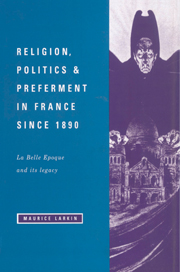Book contents
- Frontmatter
- Contents
- Preface
- Part 1 As it was: Catholics and the Republic, 1890–1914
- Part 2 As it was: Catholics and state employment, 1890–1914
- Part 3 As it became, 1914–1994
- 9 La grande illusion? 1914–1939
- 10 The leopard's spots: 1940–1960
- 11 Croquet through the looking glass: rules and identity in question, 1960–1994
- Map: Religious observance in France, c. 1960.
- Notes
- Sources
- Index
10 - The leopard's spots: 1940–1960
Published online by Cambridge University Press: 27 January 2010
- Frontmatter
- Contents
- Preface
- Part 1 As it was: Catholics and the Republic, 1890–1914
- Part 2 As it was: Catholics and state employment, 1890–1914
- Part 3 As it became, 1914–1994
- 9 La grande illusion? 1914–1939
- 10 The leopard's spots: 1940–1960
- 11 Croquet through the looking glass: rules and identity in question, 1960–1994
- Map: Religious observance in France, c. 1960.
- Notes
- Sources
- Index
Summary
Take the main road, even if it twists.
Bishop Martin of Le Puy, ‘Lettre á un jeune catholique’, 1943The 1940s present the historian with a major paradox. The record of senior churchmen during the Occupation was not a heroic one – with certain remarkable exceptions. However much they may have felt that they were protecting church members from German repression, their readiness to profit from the benign attitudes of the Vichy government in its early days left them open to the obvious charge of opportunism – while the subsequent hostility of many senior clergy to the Resistance inevitably made them seem like counter-revolutionaries, seeking to preserve ‘the Pétain miracle’ against a return of the secular Republic of the pre-war years. Whether guilty of opportunism or naivety, their record would have seemed to invite a massive outbreak of anticlerical retribution when Vichy's victims and critics eventually triumphed at the Liberation. The whole history of the previous century would suggest that such an outcome was inevitable: the anticlerical outbursts of 1830, 1871 and the 1880s had all been the price paid for the Church's complicity with the Restoration, the Second Empire and the Ordre Moral of the 1870s.
Yet nemesis did not come. On the contrary the Church emerged strengthened, while committed Catholics had a greater share of ministerial portfolios in post-war France than they had had since the 1870s. Even Vichy at its most bien pensant had not invited so many Catholics to take Cabinet posts. Moreover the situation was to continue.
- Type
- Chapter
- Information
- Religion, Politics and Preferment in France since 1890La Belle Epoque and its Legacy, pp. 174 - 193Publisher: Cambridge University PressPrint publication year: 1995



